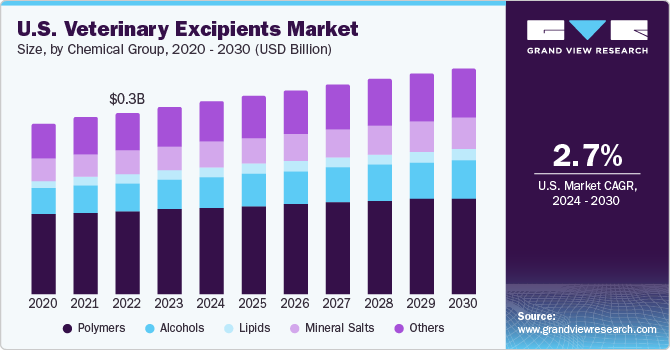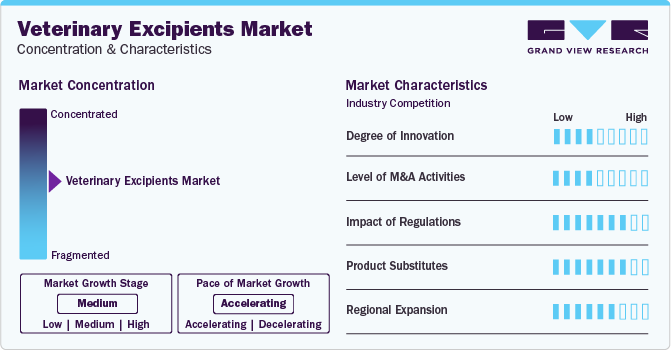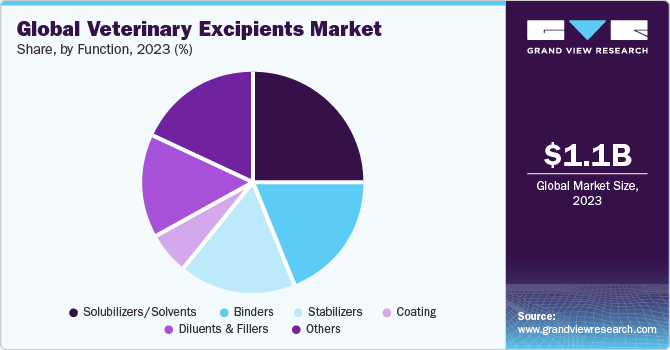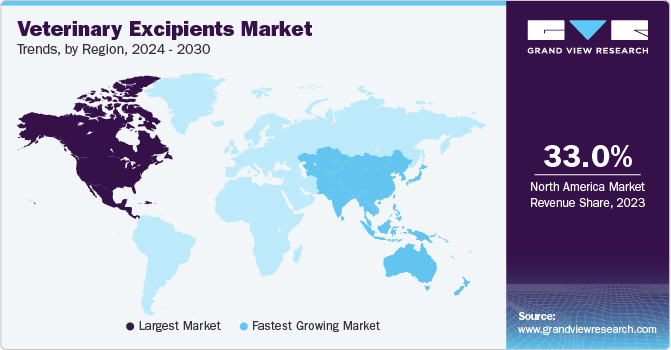- Home
- »
- Animal Health
- »
-
Veterinary Excipients Market Size And Share Report, 2030GVR Report cover
![Veterinary Excipients Market Size, Share & Trends Report]()
Veterinary Excipients Market (2024 - 2030) Size, Share & Trends Analysis Report By Application (Biologics, Pharmaceuticals, Medicated Feed Additives), By Animal Type, By Chemical Group (Polymers, Alcohols, Lipids), By Function, By Region, And Segment Forecasts
- Report ID: GVR-4-68040-182-8
- Number of Report Pages: 150
- Format: PDF
- Historical Range: 2018 - 2022
- Forecast Period: 2024 - 2030
- Industry: Healthcare
- Report Summary
- Table of Contents
- Interactive Charts
- Methodology
- Download FREE Sample
-
Download Sample Report
Veterinary Excipients Market Size & Trends
The global veterinary excipients market size was estimated at USD 1.12 billion in 2023 and is projected to grow at a compound annual growth rate (CAGR) of 4.1% from 2024 to 2030. Some of the key factors fueling this growth include the increasing number of excipient CDMOs, advancements in veterinary medicine, awareness of animal health, expenditure of animal health, and initiatives by the key players. JRS PHARMA GmbH & Co. KG, headquartered in Germany, is one the key players that offers a range of excipients such as nutritional fibers, functional fibers, and stabilizers to the veterinary sector.

As pet ownership continues to rise globally, there is an associated increase in spending on veterinary care. This trend contributes to the demand for effective veterinary medicines, thus propelling the demand for safe and high-quality excipients. As per estimates by the American Pet Products Association, Inc., American pet parents spent about USD 35.9 billion on vet care and products in 2022. This number is projected to reach USD 37 billion by 2023. This indicates a growing expenditure on vet care and products including routine veterinary care, surgeries, pharmaceuticals, and other products through veterinary clinics.
The globalization of the veterinary industry has led to increased competition and a need for manufacturers to comply with international standards. This has implications for excipient manufacturing in terms of quality control and adherence to global regulations. With the expansion of markets across borders, there is a trend toward the harmonization of regulatory standards. Regulatory bodies worldwide are working toward establishing common guidelines for the approval and registration of veterinary pharmaceuticals. This has implications for excipient manufacturers, who must ensure that their products meet these evolving global standards. For instance, the European Medicines Agency’s (EMA) updated rules on the authorization and use of veterinary medicines came into effect in January 2022 across the European Union.
Market Concentration & Characteristics
The market growth stage is medium while the it is accelerating at a notable growth rate. The market is characterized by significant degree of innovation as well as merger & acquisition activities. It is also subject to strict regulations especially in developed markets such as the U.S. and Europe. Regulatory bodies are placing greater emphasis on the safety and quality of veterinary drugs. This has led to an increased focus on compliance with regulatory standards in excipient manufacturing.
The presence of several excipient suppliers lead to a high threat of product substitutes. Moreover, market players are also involved in regional expansion to grow their market presence. Excipient manufacturers require to be well-versed in international regulations to operate in a globalized market, and to implement robust risk management strategies. Compliance with diverse regulatory frameworks becomes crucial to ensure the acceptance of excipients in various markets.

As companies cater to diverse markets with varying needs and preferences, excipient manufacturers are expected to experience an increased demand for a wide range of formulations. This includes excipients suitable for different dosage forms, delivery systems, and animal species, reflecting the global diversity in veterinary pharmaceutical products.
Also, the exchange of technology and collaboration between companies in different regions has become more common. This collaboration may involve the transfer of manufacturing processes, research and development initiatives, and technology transfer. Excipient manufacturers benefit from such collaborations by gaining access to new technologies and expertise.
Globalization provides excipient manufacturers with opportunities to access new markets and expand their customer base. Companies that can provide excipients meeting international regulatory requirements have a competitive advantage, as they can serve the needs of veterinary pharmaceutical manufacturers operating in different regions.
Function Insights
The solubilizers/ solvents segment held the highest revenue share of more than 24.0% in 2023. Solubilizers/ solvents improve drug solubility and are a crucial ingredient of most dosage forms and formulations. Gattefossé for example, is a key market player offering a range of excipients to human and animal health sectors. The company’s Transcutol V product is a solvent type of excipient for use in topical or injectable veterinary formulations. The advantages of Transcutol V include less irritation, effective solubility and good skin penetration, with an extensive toxicology and safety dossier.

The others segment, comprising disintegrants, humectants, wetting agents, lubricants/ glidants, flavoring agents & sweeteners, is estimated to grow at the fastest CAGR from 2024 2030. The significant usage and adoption of the varied ingredients in veterinary medicine fuel the segment’s growth. Disintegrants for instance make tablets breakdown faster while lubricant or glidants improve flow and process of tableting. Azelis for example is a key market player that provides ingredients such as disintegrants, binders, flow aids, colors, carriers, lubricants, and others to the veterinary sector.
Regional Insights
North America held the largest revenue share of more than 33% in 2023. Some of the key factors for such high share include an advanced veterinary care infrastructure, high animal expenditure, pet humanization, and adoption of pet insurance. Pet insurance policies offer coverage for a variety of ailments in pets from medication to surgery. This helps pet owners alleviate the financial burden of growing pet care costs while safeguarding the health their pet. The increasing humanization of pets is expected to further contribute to rising medicalization rate in pets thus leading to growing demand for medicines and excipients.

Asia Pacific is anticipated to grow at the fastest CAGR from 2024 to 2030. The animal health industry in Asia Pacific is experiencing rapid growth, driven by factors such as economic development, urbanization, and an increasing focus on animal welfare. This growth extends to both companion animals and livestock leading to an increased demand for veterinary medicines. This includes vaccines, pharmaceuticals, and medicated feed additives for companion animals, livestock, and aquaculture. As the demand for veterinary medicines grow, there is a corresponding need for high-quality excipients to facilitate the formulation and delivery of these products. Excipient manufacturers particularly from China and India are positioned to capitalize on this demand by providing essential ingredients to meet the specific requirements of diverse veterinary formulations.
Chemical Group Insights
The polymers segment dominated the market with a revenue share of about 45.0% in 2023. The wide availability and application of polymers such as polyethylene glycols, fibers/ cellulose, starch, and polysorbates/ sorbitan esters contribute to the high share of this segment. For example, Colorconspecializes in starch-based ingredients for the veterinary sector including Starch 1500, StarCap, and METHOCEL. Market players are increasingly forming partnerships and collaborations to expand their product portfolios and enhance their research and development capabilities, fueling the growth.
The lipids segment is anticipated to grow at the fastest CAGR from 2024 to 2030. Functional lipid excipients offer innovative and straightforward approaches for several challenges occurring in the manufacturing of veterinary medicine oral, topical, and parenteral formulations. For instance, in oral formulations, lipid excipients provide solutions to taste-masking and solubility enhancement challenges thereby increasing the solubility of APIs and nutraceuticals in gastrointestinal fluids. Similar benefits associated with lipid excipients is expected to contribute to the segments with a high CAGR.
Animal Type Insights
The production animals segment held the highest revenue share of more than 57.0 % in 2023. This can be attributed to notably high population of livestock animals across the globe, increasing demand for animal protein, and need to safeguard food source through biosecurity measures and safe medications. As per FAO and GVR estimates, the cattle population was estimated to be 1.5 billion in 2022 across the globe. Similarly, pig population was estimated at 0.9 billion, chicken at 26 billion, sheep at 1.3 billion, and goats at 1.1 billion respectively.
The companion animals segment is expected to register the fastest CAGR from 2024 to 2030. The key factors driving this growth include increasing humanization of pets, pet expenditure, and medicalization rate. As per Canadian Animal Health Institute (CAHI), medicalization rate of dogs was estimated at 86% whereas there was about 3% increase in the medicalization rate of cats during 2020 to 2022. This indicated a growing number of pet cats visited a vet during the period. Moreover, as per 2022 Pet Ownership & Demographic Sourcebook of the American Veterinary Medical Association (AVMA), above 75% dogs and 60% cats visited veterinarians in the previous year. As more number of pets take medications, it is expected to fuel the sale of veterinary excipients.
Application Insights
The pharmaceuticals segment accounted for the highest revenue share of more than 56.0 % in 2023. The increasing outsourcing of excipient manufacturing in the pharmaceutical industry is a key factor contributing to the segment share. Outsourcing excipients manufacturing leads to cost savings enabling pharma companies to focus on their core competencies such as drug discovery and marketing. The market is thus expected to witness increased demand for specialized excipient manufacturers that can provide high-quality ingredients in the coming years.
The biologics segment is projected to grow at the fastest CAGR from 2024 to 2030. The growing focus on preventive veterinary care as well as complexity of manufacturing biologics is estimated to propel this segment’s growth. The Montanide range offered by SEPPIC comprises vaccine adjuvants for the veterinary sector. The product range includes Montanide ISA oil-based adjuvants, Montanide IMS ready-to-dilute adjuvants, and Montanide GEL polymeric adjuvants. SPI Pharma, another key market player offers aluminium hydroxide gel range of vaccine adjuvants for human and veterinary applications.
Key Companies & Market Share Insights
Market players compete based on the diversity and quality of their product portfolios. Continuous innovation in excipient formulations to meet the evolving requirements of veterinary medicines, such as taste masking, controlled release, and improved stability, is a key competitive factor. Companies that adhere to stringent quality control measures and regulatory requirements gain the trust of pharmaceutical manufacturers, leading to a competitive advantage. Seppic for instance manufactures its veterinary adjuvants in accordance with the International Pharmaceutical Excipient Council (IPEC) manufacturing guidelines.
Key Veterinary Excipients Companies:
- Croda International Plc
- JRS PHARMA GmbH & Co. KG
- Colorcon
- Quality Chemicals S.L.
- IOI Oleo GmbH
- Lipoid GmbH
- Gattefossé Group
- Azelis Group
- Ashland.Inc.
- Spectrum Chemical Mfg. Corp
Recent Developments
-
In December 2022, Azelis opened a new office in Bangladesh to strengthen its footprint in South Asia and expand offerings to its customers.
-
In November 2021, Seppic launched an aqueous adjuvant— MONTANIDE GEL P PR for injectable vaccines dedicated to avian species.
-
In July 2019, Colorcon announced its plan to build a starch manufacturing facility in Netherlands in response to growing demand for its excipients across the globe.
Veterinary Excipients Market Report Scope
Report Attribute
Details
Market size value in 2024
USD 1.17 billion
Revenue forecast in 2030
USD 1.49 billion
Growth rate
CAGR of 4.1% from 2024 to 2030
Base year for estimation
2023
Historical data
2018 - 2022
Forecast period
2024 - 2030
Quantitative units
Revenue in USD million/billion and CAGR from 2024 to 2030
Report coverage
Revenue forecast, company ranking, competitive landscape, growth factors, and trends
Segments covered
Application, chemical group, animal type, function, region
Regional scope
North America; Europe; Asia Pacific; Latin America; MEA
Country scope
U.S.; Canada; UK; Germany; France; Italy; Spain; Denmark; Sweden; Norway; Japan; China; India; Australia; Thailand; South Korea; Brazil; Mexico; Argentina; South Africa; Saudi Arabia; UAE, Kuwait
Key companies profiled
Croda International Plc; JRS PHARMA GmbH & Co. KG; Colorcon; Quality Chemicals S.L; IOI Oleo GmbH; Lipoid GmbH; Gattefossé Group; Azelis Group; Ashland Inc.; Spectrum Chemical
Customization scope
Free report customization (equivalent up to 8 analysts working days) with purchase. Addition or alteration to country, regional & segment scope.
Pricing and purchase options
Avail customized purchase options to meet your exact research needs. Explore purchase options
Global Veterinary Excipients Market Report Segmentation
This report forecasts revenue growth at global, regional, and country levels and provides an analysis of the latest industry trends in each of the sub-segments from 2018 to 2030. For this study, Grand View Research has segmented the global veterinary excipients market report based on application, animal type, chemical group, function, and region:
-
Application Outlook (Revenue, USD Million, 2018 - 2030)
-
Biologics
-
Pharmaceuticals
-
Medicated Feed Additives
-
-
Chemical Group Outlook (Revenue, USD Million, 2018 - 2030)
-
Polymers
-
Alcohols
-
Lipids
-
Mineral Salts
-
Others
-
-
Animal Type Outlook (Revenue, USD Million, 2018 - 2030)
-
Production Animals
-
Companion Animals
-
-
Function Outlook (Revenue, USD Million, 2018 - 2030)
-
Solubilizers/ Solvents
-
Binders
-
Stabilizers
-
Coating
-
Diluents & Fillers
-
Others
-
-
Regional Outlook (Revenue, USD Million, 2018 - 2030)
-
North America
-
U.S.
-
Canada
-
-
Europe
-
Germany
-
UK
-
France
-
Italy
-
Spain
-
Denmark
-
Norway
-
Sweden
-
Rest of Europe
-
-
Asia Pacific
-
Japan
-
China
-
India
-
South Korea
-
Australia
-
Thailand
-
Rest of Asia Pacific
-
-
Latin America
-
Brazil
-
Mexico
-
Argentina
-
Rest of Latin America
-
-
Middle East & Africa
-
South Africa
-
Saudi Arabia
-
Kuwait
-
UAE
-
Rest of MEA
-
-
Frequently Asked Questions About This Report
b. The global veterinary excipients market size was estimated at USD 1.12 billion in 2023 and is expected to reach USD 1.17 billion in 2024.
b. The global veterinary excipients market is expected to grow at a compound annual growth rate of 4.1% from 2024 to 2030 to reach USD 1.49 billion by 2030.
b. By region, North America attributed to the largest share of about 33% of the market in 2023. Some of the key factors for such high share include an advanced veterinary care infrastructure, high animal expenditure, pet humanization, and adoption of pet insurance.
b. Some key players operating in the veterinary excipients market include Croda International Plc; JRS PHARMA GmbH & Co. KG; Colorcon; Quality Chemicals S.L; IOI Oleo GmbH; Lipoid GmbH; Gattefossé Group; Azelis Group; Ashland Inc.; and Spectrum Chemical.
b. Some of the key factors accounting for market growth include increasing number of excipients CDMOs, advancements in veterinary medicine, awareness of animal health, animal health expenditure, and initiatives by market players.
Share this report with your colleague or friend.
Need a Tailored Report?
Customize this report to your needs — add regions, segments, or data points, with 20% free customization.

ISO 9001:2015 & 27001:2022 Certified
We are GDPR and CCPA compliant! Your transaction & personal information is safe and secure. For more details, please read our privacy policy.
Trusted market insights - try a free sample
See how our reports are structured and why industry leaders rely on Grand View Research. Get a free sample or ask us to tailor this report to your needs.










